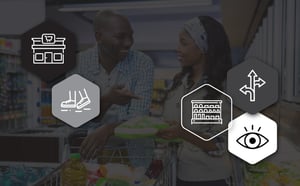Have you ever walked into a store and felt like an unseen force was guiding you in a specific direction? Perhaps you visited to buy groceries, and the store flow took you past the sweets aisle. Suddenly you found yourself wanting biscuits to go with your afternoon tea or coffee. As you walk out with more than you intended to buy, you're confused about how it happened.
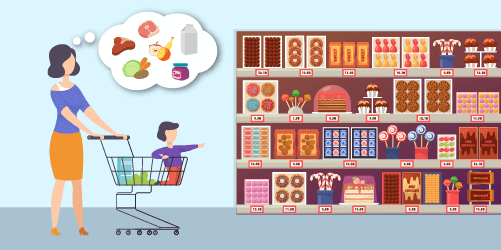
It happened through the combination of strategically planned techniques that all retail stores use today. They display products and layout their store in a way to encourage customers to buy more. They achieve that by using space planning techniques that make shoppers stay in stores for longer, increasing the likelihood that they'll buy more. You can use these techniques too.
But what are these space planning techniques? How do they influence your customers to walk through and spend more time in-store? More importantly, how can you use them to provide your customers with what they want so that you can benefit from the additional sales?

1. Make the most of your decompression zone
Before your customers walk into your store, they know that they're about to make a conscious effort to consider the products on the shelf. Do they buy Brand A or Brand B? Do they need that product that'll make their life easier today, or will they buy it another day? Do they make that impulse buy while they're standing in the queue? The questions are endless.
It can also be daunting if they visit with only an idea of what they need.
Knowing this, you can ensure to design a shopping experience that will reduce any unnecessary anxiety, making the experience better. One way of doing that is by making the most of your decompression zone.
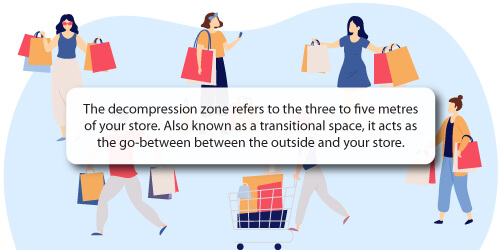
This decompression zone can help your customers open their minds and ready themselves for the shopping experience. You can also use this area to set them at ease and show them what to expect if they decide to walk further into your store.
So what goes into a good decompression zone, and one that can pull customers into your store?
- It must be an open space free of clutter
The last thing you want is to overcrowd the entrance of your store with displays that stop customers and prevent others from seeing or moving into your store.
- It allows for an easy entrance into your store with an overview of your merchandise
It’s not a bad idea to have a few displays or one or two stands that show customers what they can expect. With displays, it’s best to position them out of the way to not block customers from walking into or out of your store.
- There are no distracting marketing or advertising gimmicks
The decompression zone is meant to act as an area where your customers can get into the mood to shop. You also want to use it to get them to move further into your store. That’s why it’s not a good idea to use this space to put up advertising stands that crowd the space.
- It must give your customers space to breathe
As with the above points, you want to use the space within your decompression zone to allow your customers to acclimatize and get into the mood to shop.
- It should include displays to entice customers into your store
By including visually appealing displays, you can tempt customers to walk past the threshold and into your store. That could include flower displays or any other aesthetically pleasing or mood-setting exhibits.

2. Direct shoppers around your store
One of your goals is to maximize your sales. The other is to please your customers. And in reality, you can’t have one without the other. That’s why it’s critical to ensure that you make the shopping experience as easy as possible for your customers.
That includes understanding how customers shop at your store.
In the past, it was generally accepted that you set up your store so that people shop from right to left. Entrepreneur.com quotes Brian Dyches, chief experience officer of retail branding firm, Ikonic Tonic, who says that studies have shown people to look left first, then right before entering a store. They would also prefer to move right and walk counterclockwise.
Are you setting up your store plan but not sure where to begin? Let DotActiv help! Book a free exploratory consultation to find out how.
However, that doesn’t mean you shouldn’t consider doing the opposite to arouse the attention of any shoppers who walk into your store. The key is to ensure that they can still find what they need. If shoppers walk into your store and can find what they need without trouble, you’re in a good position. If the opposite is true, it’s worth relooking at your layout.
The other argument is that if you don’t direct shoppers once they enter your store, they’ll be unsure about where to go. Should they go left? Should they go right? Straight? It’s best to point them in a direction, be that through signage, a display, or an open area.

3. Slow down shoppers
It’s one thing to entice shoppers into a store. It’s an entirely different thing to keep them there, engaged and filling their baskets. But it is possible.
It’s through visual breaks, also known as speed bumps. These speed bumps allow you to slow down your customers and let them look around. You want them to browse the products in your store rather than walk in, get an item, and pay.
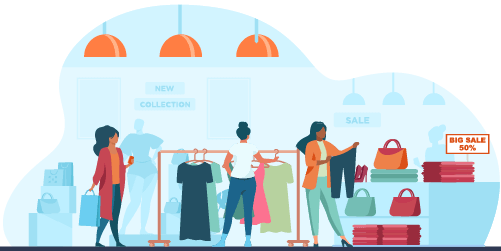
Another way is to stock the most frequently bought items at the back of your store. These are your staples like bread, milk, and cheese.
By doing this, you can achieve the following:
- Maximize the time your customers spend in your store;
- Increase the basket sizes as they make impulse buys; and
- Stop shoppers from walking in and out of your store in minutes.
Mind you, you must be careful here - it’s not about preventing them from leaving your store. Instead, it’s about presenting your products so they are encouraged to stay. It’s subtle - you want them to stay and shop because they want to and not before they can't get out.

4. Ensure your store is visually appealing and pleasant to shop
Merchandising is a critical component to get right if you want to entice your customers to buy your products.
There are also plenty of different merchandising techniques and strategies to encourage your customers to buy more. It all depends on the role you give your categories and what you want to achieve.
The four primary merchandising techniques are:
- Vertical merchandising
This technique presents your items in a vertical display within line of sight. It allows your customers to follow the products on offer with their eyes, from top to bottom.
- Horizontal merchandising
This technique allows you to present products in a blocked, horizontal manner. It also ensures that all goods are a customer’s line of sight and allows them to view products from left to right.
- Cross-Merchandising
Often referred to as cross-selling, cross-merchandising entails placing complementary products from separate categories together. The goal is to provide your customers with solutions - and save them time.
- Colour block merchandising
You can use the color block merchandising technique to group products of similar colors. You’d usually complete this in a vertical fashion, which is why you often hear it referred to as color ribboning.
Alongside these techniques, it’s also worth considering atmospherics. In the same way that your store interior has the power to contribute to the sale of products, atmospherics can influence your customers to purchase products.
Atmospherics refers to the mood you create in your store by using elements and effects and appealing to the senses.

5. Use your available shelf space strategically
This much is true - you have a limited amount of shelf space. That’s why you must use it as strategically as possible. But how?
Some believe that eye level is to be the best spot to place your product. That’s certainly true if you consider that many retailers place their best-selling items here. More customers will see them, is the one argument, while the other is that ‘eye-level is buy level’.
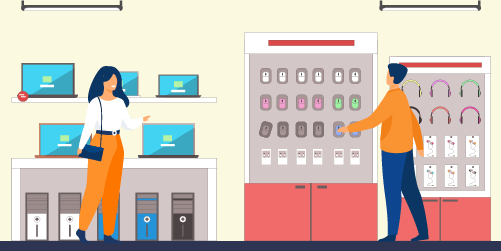
On the other hand, there are your end caps. Also known as gondola ends, these are the shelves at the end of your aisles. You can use them to pull customers into an aisle by setting up specials or adding a technological element to draw them closer.
Whichever of these space planning techniques you use - we’d suggest both in equal measure - they can help you to encourage shoppers to buy more. And ‘encourage’ is the operative word here.
You’re not forcing customers to buy. You’d give them all the information they need to make a decision. It helps when you make that decision as easy as possible. After all, if you can create an in-store experience where it doesn’t seem like customers are shopping but rather enjoying themselves, you can expect more sales.
Conclusion
By implementing the above space planning techniques, you can create an aesthetically pleasing layout, allowing your customers to find the products they want easily. You’re also welcome to test these techniques first by doing a realogram. Once you’ve implemented a planogram, you can evaluate the two to determine technique effectiveness.
Either way, you can ensure an efficient flow around your store and comfortable shopping for your customers, which leads to them staying for longer and spending more.
If you’re looking to optimize your retail space and maximize your sales, why not speak to us? You can book a complimentary custom consultation with a DotActiv expert today and we’ll help you reach your goals and objectives, no matter what they are. You’re also welcome to browse through our various paid software editions on our online store here.


